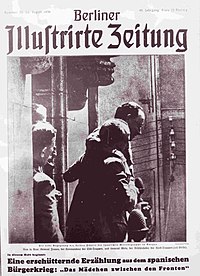Berliner Illustrirte Zeitung
 |
|

Cover of issue of 26 August 1936: first meeting between Francisco Franco and Emilio Mola
|
|
| Frequency | weekly |
|---|---|
| Year founded | 1891 |
| First issue | 4 January 1892 |
| Final issue | 1945 |
| Company | Ullstein Verlag |
| Country | Germany |
| Based in | Berlin |
| Language | German |
The Berliner Illustrirte Zeitung, often abbreviated BIZ, was a weekly illustrated magazine published in Berlin from 1892 to 1945. It was the first mass-market German magazine and pioneered the format of the illustrated news magazine.
The Berliner Illustrirte was published on Thursdays but bore the date of the following Sunday.
The magazine was founded in November 1891 by a Silesian businessman named Hepner and published its first issue on 4 January 1892 under Otto Eysler, who also published Lustige Blätter. In 1894, Leopold Ullstein, the founder of the publishing house Ullstein Verlag, bought it. In 1897 it cost RM 1.50 per quarter, as compared to a competing weekly which had been founded earlier, the Illustrirte Zeitung, which had approximately twice as many pages and cost RM 7 per year, prohibitively expensive for all but the well to do. Technical advances including photo-offset printing, the linotype machine and cheaper production of paper later made it possible to sell it for 10 pfennigs an issue, which was within the reach even of workers; at the suggestion of the business manager, David Cohn, Ullstein lifted the subscription requirement, and sold in the street (which had been illegal until 1904), at station kiosks and in drinking establishments and with its own female representatives selling subscriptions, it became the first mass-market periodical in Germany. (The price doubled to 20 pfennigs in November 1923 when the currency was stabilised after the runaway inflation of the early 1920s.)
Once it no longer required a subscription, the Berliner Illustrirte fundamentally changed the newspaper market, attracting readers by its appearance, particularly the eye-catching pictures. The first cover created a sensation, featuring a group portrait of officers who had been killed in a shipwreck. Initially it was illustrated with engravings, but it soon embraced photographs. Beginning in 1901, it was also technically feasible to print photographs inside the magazine, a revolutionary innovation. Building on the example of a rival Berlin publication, August Scherl's Die Woche, Ullstein developed it into the prototype of the modern news magazine. It pioneered the photo-essay, had a specialised staff and production unit for pictures and maintained a photo library. With other news magazines like the Münchner Illustrierte Presse in Munich and Vu in France, it also pioneered the use of candid photographs taken with the new smaller cameras. In August 1919, a cover photograph of the German President Friedrich Ebert and Minister of Defence Gustav Noske on holiday on the Baltic coast, clad in swimming trunks, caused heated debate about propriety; within a decade, such informality would seem normal. Kurt Korff (Kurt Karfunkelstein), then the editor in chief, pointed out in 1927 the parallel with the rise of the cinema, another aspect of the increasing role of "life 'through the eyes'". He and publishing director Kurt Szafranski sought out reporters who could tell a story using photographs, notably the pioneer sports photographer Martin Munkácsi, the first staff photographer at a German illustrated magazine, and Erich Salomon, one of the founders of photo-journalism. After initially working in advertising for Ullstein, Salomon signed an exclusive contract with the Berliner Illustrirte as a photographer and contributed both inside shots of meetings of world leaders and photo-essays on the strangeness of life in the USA, for example eating at automats (for which he used staged photographs depicting himself being schooled in how it was done).
...
Wikipedia
